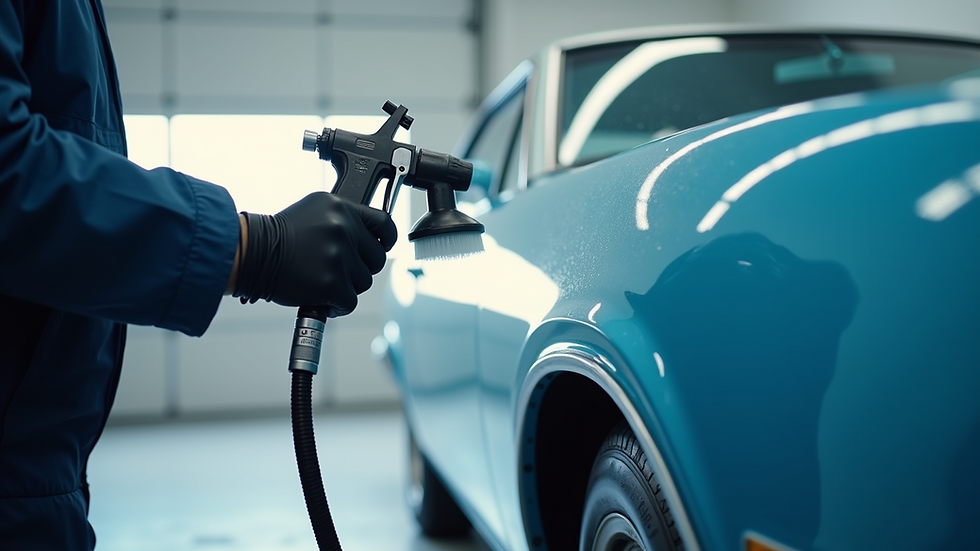Exploring Auto Body Refinishing Techniques
- markmontes84
- Sep 15
- 4 min read
When a vehicle sustains damage, restoring its appearance and structural integrity requires precise and effective methods. Auto body refinishing is a critical process that ensures your vehicle looks as good as new after repairs. We will explore the essential techniques used in auto body refinishing, focusing on practical applications and the latest industry standards. This knowledge will help you understand what to expect when your vehicle undergoes repair and how professionals achieve flawless results.
Understanding Auto Body Refinishing Techniques
Auto body refinishing involves several steps designed to restore the vehicle’s exterior surface. The process begins with assessing the damage and preparing the surface for repair. This preparation is crucial because it affects the adhesion and finish quality of the paint.
The primary techniques include:
Surface Preparation: This involves sanding, cleaning, and sometimes applying fillers to smooth out dents or scratches.
Priming: A primer coat is applied to create a uniform base and improve paint adhesion.
Painting: Multiple layers of paint are sprayed on, often using advanced spray guns for even coverage.
Clear Coating: A clear coat protects the paint and adds gloss.
Polishing and Buffing: The final step enhances the shine and removes minor imperfections.
Each step requires attention to detail and the right equipment. For example, sanding must be done with the correct grit to avoid damaging the metal or plastic beneath. Primers and paints must be compatible with the vehicle’s original finish to ensure durability.

Surface preparation is the foundation of a quality auto body refinishing job.
Key Auto Body Refinishing Techniques in Detail
Let’s delve deeper into the specific techniques that define professional auto body refinishing.
Surface Preparation and Repair
Before any paint touches the vehicle, the surface must be flawless. This step includes:
Cleaning: Removing dirt, grease, and old paint residues.
Sanding: Using various sandpaper grits to smooth the surface and remove imperfections.
Filling: Applying body fillers to dents or deep scratches, then sanding them smooth.
Masking: Protecting areas that should not be painted, such as windows and trim.
Proper surface preparation ensures the paint adheres well and lasts longer. Skipping or rushing this step often leads to peeling or bubbling paint.
Primer Application
Primers serve as a bonding agent between the metal or plastic surface and the paint. They also prevent rust and corrosion. There are different types of primers:
Epoxy primers: Excellent for corrosion resistance.
Urethane primers: Provide a smooth surface for paint.
Etching primers: Used on bare metal to improve adhesion.
Applying the primer evenly and allowing it to cure properly is essential. Professionals use spray booths with controlled environments to avoid dust and contaminants.
Painting Process
The painting stage is where the vehicle regains its color and finish. Modern techniques include:
Base Coat Application: The base coat provides the color. It is applied in thin, even layers.
Metallic and Pearl Paints: These require special handling to ensure the particles are evenly distributed.
Waterborne Paints: Environmentally friendly and increasingly popular, these paints require precise humidity and temperature control.
Spray guns with adjustable nozzles and air pressure settings allow technicians to apply paint uniformly. Multiple coats may be necessary to achieve the desired depth and color match.

Precision spray painting ensures a smooth and even color finish.
Clear Coat Application and Finishing
The clear coat is a transparent layer that protects the paint from UV rays, chemicals, and minor scratches. It also adds gloss and depth to the color.
Application: Clear coats are sprayed on in multiple layers.
Curing: Proper curing time is critical to avoid soft or dull finishes.
Polishing: After curing, the surface is polished and buffed to remove any imperfections and enhance shine.
This step requires skill to avoid orange peel texture or runs in the finish.
Advanced Techniques and Technologies in Auto Body Refinishing
The auto body refinishing industry continuously evolves with new technologies and methods. Staying updated with these advancements ensures the highest quality repairs.
Computerized Color Matching
Matching the original paint color is one of the most challenging aspects of refinishing. Modern shops use computerized color matching systems that analyze the vehicle’s paint and mix the exact formula. This technology reduces guesswork and improves consistency.
Environmentally Friendly Practices
Waterborne paints and low-VOC (volatile organic compounds) products are becoming standard. These materials reduce environmental impact and improve air quality in repair shops.
Laser and Digital Measuring Tools
Precision in bodywork is enhanced by laser measuring systems that detect frame damage and misalignments. Accurate measurements ensure that repairs restore the vehicle to manufacturer specifications.

Laser measuring tools provide precise damage assessment for accurate repairs.
Why Choose Professional Auto Body Refinishing Services?
Choosing a professional service for your vehicle’s refinishing needs guarantees quality and reliability. Professionals have the expertise, equipment, and materials to deliver results that meet or exceed manufacturer standards.
Durability: Proper refinishing extends the life of your vehicle’s exterior.
Aesthetic Appeal: A flawless finish maintains your vehicle’s value and appearance.
Safety: Correct repairs ensure structural integrity and safety.
Warranty: Reputable shops offer warranties on their work, providing peace of mind.
For those seeking trusted service in Owosso and Shiawassee County, auto body refinishing professionals deliver consistent, high-quality results.
Maintaining Your Vehicle’s Refinished Surface
After investing in expert refinishing, maintaining the finish is essential. Follow these recommendations:
Regular Washing: Use mild detergents and avoid harsh chemicals.
Waxing: Apply wax every few months to protect the clear coat.
Prompt Repairs: Address chips and scratches quickly to prevent rust.
Safe Parking: Avoid parking under trees or in areas prone to damage.
Proper care preserves the refinished surface and keeps your vehicle looking its best.
By understanding these auto body refinishing techniques, you can make informed decisions when your vehicle requires repair. The process demands precision, skill, and the right materials to restore your vehicle’s appearance and value. Trusting experienced professionals ensures your vehicle receives the care it deserves.


Comments